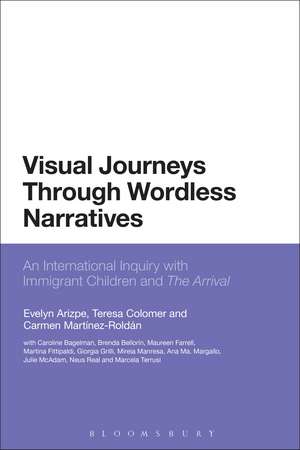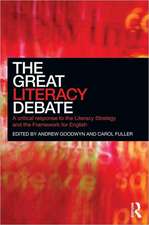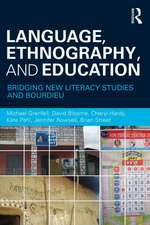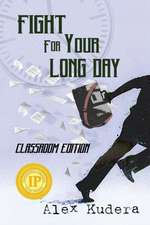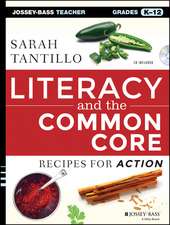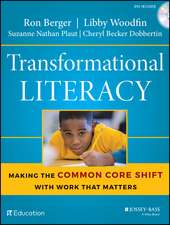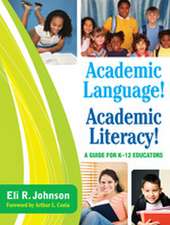Visual Journeys Through Wordless Narratives: An International Inquiry With Immigrant Children and The Arrival
Autor Dr Evelyn Arizpe, Dr Teresa Colomer, Dr Carmen Martínez-Roldánen Limba Engleză Hardback – 23 apr 2014
| Toate formatele și edițiile | Preț | Express |
|---|---|---|
| Paperback (1) | 258.42 lei 6-8 săpt. | +94.17 lei 7-13 zile |
| Bloomsbury Publishing – 18 noi 2015 | 258.42 lei 6-8 săpt. | +94.17 lei 7-13 zile |
| Hardback (1) | 833.06 lei 6-8 săpt. | |
| Bloomsbury Publishing – 23 apr 2014 | 833.06 lei 6-8 săpt. |
Preț: 833.06 lei
Preț vechi: 1066.30 lei
-22% Nou
Puncte Express: 1250
Preț estimativ în valută:
159.40€ • 166.88$ • 131.90£
159.40€ • 166.88$ • 131.90£
Carte tipărită la comandă
Livrare economică 05-19 aprilie
Preluare comenzi: 021 569.72.76
Specificații
ISBN-13: 9781780937588
ISBN-10: 178093758X
Pagini: 288
Ilustrații: 10 illus
Dimensiuni: 156 x 234 x 23 mm
Greutate: 0.57 kg
Ediția:New.
Editura: Bloomsbury Publishing
Colecția Bloomsbury Academic
Locul publicării:London, United Kingdom
ISBN-10: 178093758X
Pagini: 288
Ilustrații: 10 illus
Dimensiuni: 156 x 234 x 23 mm
Greutate: 0.57 kg
Ediția:New.
Editura: Bloomsbury Publishing
Colecția Bloomsbury Academic
Locul publicării:London, United Kingdom
Caracteristici
Approach to visual texts provides pedagogical strategies for use with immigrant and second language learners
Notă biografică
Evelyn Arizpe is Senior Lecturer in the School of Education, University of Glasgow, UK.Teresa Colomer is Professor at the Facultdad de Ciencias de la Educación, Universitat Autònoma de Barcelona, Spain.Carmen Martínez-Roldán is Associate Professor of Bilingual/Bicultural Education at Teachers College, Columbia University, USA.
Cuprins
Foreword Shaun Tan IntroductionPart I: Embarking on the Journey1. The Vessel: Theoretical Frameworks and Intersections2. The Passengers: International Contexts and Participants3. The Voyage: The Course of the InquiryPart II: Navigating the Interpretive Process4. Reclaiming the Migrant Experience 5. Making Meaning through Retellings and Inferences6. Re-orientating Cultural Identity through Intertextual Response7. Engaging with the Visual Affordances of The Arrival Part III: Mediation and Pedagogy: Transforming Literacy Learning and Teaching8. Fostering a Community: Mediation that Supports Learning9. Looking Together: Visual Strategies for Inclusive Pedagogy10. Conclusion: Arriving and the Journey AheadCoda: A (Visual) Journey to Italy: Bewilderment, Surprise and Wonder in Reading a 'Silent Book' Giorgia Grilli and Marcella TerrusiAppendix: List of Participant ChildrenBibliographyIndex
Recenzii
Visual Journeys Through Wordless Narratives is a particularly timely and important publication ... a thoughtful reflection on the way immigrant children are often treated in busy classrooms and schools
While images are sometimes marginalized in educational texts as mere scaffolding to understand written words, this book makes the case that an intertextual literacy experience, or even an experience based mainly in images, can be valuable for children from diverse backgrounds.
Visual Journeys Through Wordless Narratives provides an in-depth look at how multimodal texts offer openings for students from (im)migrant backgrounds to mobilize their transnational knowledge in the classroom. Arizpe, Colmer and Martínez-Roldán's work embodies the spirit of the texts they feature and their resource orientations to students. Through cross-cultural collaborations and research methodologies that attend to visual modalities, they provide a rich example of 21st century literacies that is sure to inspire researchers and teachers alike.
Product of an outstanding international research team, Visual Journeys Through Wordless Narratives offers the reader narratives by immigrant children about their feelings, emotions, experiences and knowledge inspired by Shaun Tan's famous picture book The Arrival. Anchored in the metaphor of the journey, and using a visual journey as support, this unique, fascinating, and well-organized volume is a fine tribute to Tan and a genuine hymn to teaching and integration of immigrant children from diverse cultural and linguistic origins.
This is a very important book. It is timely as it appears at a time when educators are beginning to explore the important place of visual literacy in intercultural education and in language education as migrations brings new diversities to classrooms worldwide. It offers, significantly, important resources for opening out the imagination and enabling new visions of critical and social learning to emerge, in a scaffolded context. The authors have produced an invigorating and excitingly intellectual contribution to the field of intercultural literacy studies.
In this evocative book, Evelyn Arizpe and her co-authors reflect on their ambitious research project to explore responses of immigrant children in Glasgow, Barcelona and Arizona to Shaun Tan's complex wordless picturebook, The Arrival. Framed by Tan's eloquent introduction and by the authors' in-depth analyses of the students' responses, the book offers readers new understandings of the power of visual narratives to engage these young immigrants' literacy skills, personal reflections and imaginative powers. This is an important new international addition to texts on picturebooks, visual literacy and issues of immigration.
Excellent research that examines the personal and social complexity of the immigration from the perspective of children's response on that subject in the picturebook. This study offers much more than an analysis of reception and interpretation of children's literature. Through a rigorous methodology of ethnographic and collaborative nature, this study contrasts the perceptions of informants from three contexts (Glasgow, Arizona and Barcelona) and feedback from children about their experience and their experiences on immigration are evaluated. The careful methodology of this study exposes the process of the navigating the interpretive Process up to conclusions on Cultural Identity, Learning and Teaching mediation and to determine strategies for Inclusive Pedagogy. Topicality of the subject and the prospects of analysis of this research point to the visual strategies as a key reference for inclusive and collaborative innovation in Literacy.
In my opinion the book Visual Journeys Through Wordless Narratives manages to meet three important challenges:- A number of university research groups, not just from different countries, but also from different continents, have got together as a consequence of the research carried out on the book The Arrival, by Shaun Tan. This fact shows, on one hand, the quality of the object of study and, on the other, the "universal" benefits of university exchanges.- The scientific rigor with which the research has been carried out. This can be proven both by the up-to-date bibliography used, and by the systematic organization and account of the different themes investigated. This issue is also reflected in the book's index; its chapters open new perspectives for specific studies in various issues.- The affinity between Shaun Tan's immigrant lead character and the identity of the research young subjects, as well as the identity of some of the members of the research team, confer the study a very high degree of reliability in its conclusions.In short, the main character in The Arrival has reached a very appealing place (if by "place" we understand the solid pages in this fascinating inter-university study). He has a very encouraging horizon ahead for the education in the field of visual narratives, in particular starting from wordless picture books, which constitute very powerful tools both for social integration and for artistic innovation.
This fascinating and remarkable international research bears close reading and re-reading. A highly significant examination of the potential of wordless picturebooks to support immigrant children as learners and meaning makers, it is inspiring, thought provoking and engaging. This important book also reveals the critical nature of the teacher's role in developing literary understanding through image based narratives and offers new hope for intercultural understanding in the classroom.
Visual Journeys ... is a fascinating account of an international research product ... designed to investigate the use of wordless visual narratives with children from different ethnic minority and immigrant backgrounds [...] The considerable achievement of Visual Journeys is that ... it has provided 'thick' data that should inspire teachers to adopt similar approaches to working on wordless narratives with young learners
The journey undertaken by children and educators in this inquiry tells the story of the transformational power of dialogue and visual images in providing a context for critique, hope and action. This book meets a critical need in the field through exploring issues of literacy and identity within the increasingly complex lives of children across global communities.
With empirical finesse and theoretical bite, this path-breaking investigation explores an original way to mobilize our empathy towards the vulnerable others. Inviting us to imagine the world outside ourselves and to go beyond the discourse of global compassion performed in our humanitarian media environment, the book asks us to get in touch with our sense of belonging to a wider moral community. Experiencing wonder and bewilderment in the pages of a book can be a great apprenticeship to exercise one's own orientation, active citizenship and openness to what's different in the real world.
While images are sometimes marginalized in educational texts as mere scaffolding to understand written words, this book makes the case that an intertextual literacy experience, or even an experience based mainly in images, can be valuable for children from diverse backgrounds.
Visual Journeys Through Wordless Narratives provides an in-depth look at how multimodal texts offer openings for students from (im)migrant backgrounds to mobilize their transnational knowledge in the classroom. Arizpe, Colmer and Martínez-Roldán's work embodies the spirit of the texts they feature and their resource orientations to students. Through cross-cultural collaborations and research methodologies that attend to visual modalities, they provide a rich example of 21st century literacies that is sure to inspire researchers and teachers alike.
Product of an outstanding international research team, Visual Journeys Through Wordless Narratives offers the reader narratives by immigrant children about their feelings, emotions, experiences and knowledge inspired by Shaun Tan's famous picture book The Arrival. Anchored in the metaphor of the journey, and using a visual journey as support, this unique, fascinating, and well-organized volume is a fine tribute to Tan and a genuine hymn to teaching and integration of immigrant children from diverse cultural and linguistic origins.
This is a very important book. It is timely as it appears at a time when educators are beginning to explore the important place of visual literacy in intercultural education and in language education as migrations brings new diversities to classrooms worldwide. It offers, significantly, important resources for opening out the imagination and enabling new visions of critical and social learning to emerge, in a scaffolded context. The authors have produced an invigorating and excitingly intellectual contribution to the field of intercultural literacy studies.
In this evocative book, Evelyn Arizpe and her co-authors reflect on their ambitious research project to explore responses of immigrant children in Glasgow, Barcelona and Arizona to Shaun Tan's complex wordless picturebook, The Arrival. Framed by Tan's eloquent introduction and by the authors' in-depth analyses of the students' responses, the book offers readers new understandings of the power of visual narratives to engage these young immigrants' literacy skills, personal reflections and imaginative powers. This is an important new international addition to texts on picturebooks, visual literacy and issues of immigration.
Excellent research that examines the personal and social complexity of the immigration from the perspective of children's response on that subject in the picturebook. This study offers much more than an analysis of reception and interpretation of children's literature. Through a rigorous methodology of ethnographic and collaborative nature, this study contrasts the perceptions of informants from three contexts (Glasgow, Arizona and Barcelona) and feedback from children about their experience and their experiences on immigration are evaluated. The careful methodology of this study exposes the process of the navigating the interpretive Process up to conclusions on Cultural Identity, Learning and Teaching mediation and to determine strategies for Inclusive Pedagogy. Topicality of the subject and the prospects of analysis of this research point to the visual strategies as a key reference for inclusive and collaborative innovation in Literacy.
In my opinion the book Visual Journeys Through Wordless Narratives manages to meet three important challenges:- A number of university research groups, not just from different countries, but also from different continents, have got together as a consequence of the research carried out on the book The Arrival, by Shaun Tan. This fact shows, on one hand, the quality of the object of study and, on the other, the "universal" benefits of university exchanges.- The scientific rigor with which the research has been carried out. This can be proven both by the up-to-date bibliography used, and by the systematic organization and account of the different themes investigated. This issue is also reflected in the book's index; its chapters open new perspectives for specific studies in various issues.- The affinity between Shaun Tan's immigrant lead character and the identity of the research young subjects, as well as the identity of some of the members of the research team, confer the study a very high degree of reliability in its conclusions.In short, the main character in The Arrival has reached a very appealing place (if by "place" we understand the solid pages in this fascinating inter-university study). He has a very encouraging horizon ahead for the education in the field of visual narratives, in particular starting from wordless picture books, which constitute very powerful tools both for social integration and for artistic innovation.
This fascinating and remarkable international research bears close reading and re-reading. A highly significant examination of the potential of wordless picturebooks to support immigrant children as learners and meaning makers, it is inspiring, thought provoking and engaging. This important book also reveals the critical nature of the teacher's role in developing literary understanding through image based narratives and offers new hope for intercultural understanding in the classroom.
Visual Journeys ... is a fascinating account of an international research product ... designed to investigate the use of wordless visual narratives with children from different ethnic minority and immigrant backgrounds [...] The considerable achievement of Visual Journeys is that ... it has provided 'thick' data that should inspire teachers to adopt similar approaches to working on wordless narratives with young learners
The journey undertaken by children and educators in this inquiry tells the story of the transformational power of dialogue and visual images in providing a context for critique, hope and action. This book meets a critical need in the field through exploring issues of literacy and identity within the increasingly complex lives of children across global communities.
With empirical finesse and theoretical bite, this path-breaking investigation explores an original way to mobilize our empathy towards the vulnerable others. Inviting us to imagine the world outside ourselves and to go beyond the discourse of global compassion performed in our humanitarian media environment, the book asks us to get in touch with our sense of belonging to a wider moral community. Experiencing wonder and bewilderment in the pages of a book can be a great apprenticeship to exercise one's own orientation, active citizenship and openness to what's different in the real world.
